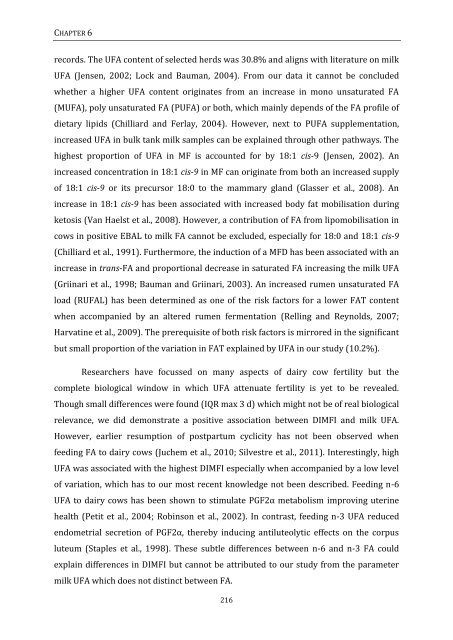view - Department of Reproduction, Obstetrics and Herd Health
view - Department of Reproduction, Obstetrics and Herd Health
view - Department of Reproduction, Obstetrics and Herd Health
You also want an ePaper? Increase the reach of your titles
YUMPU automatically turns print PDFs into web optimized ePapers that Google loves.
CHAPTER 6<br />
records. The UFA content <strong>of</strong> selected herds was 30.8% <strong>and</strong> aligns with literature on milk<br />
UFA (Jensen, 2002; Lock <strong>and</strong> Bauman, 2004). From our data it cannot be concluded<br />
whether a higher UFA content originates from an increase in mono unsaturated FA<br />
(MUFA), poly unsaturated FA (PUFA) or both, which mainly depends <strong>of</strong> the FA pr<strong>of</strong>ile <strong>of</strong><br />
dietary lipids (Chilliard <strong>and</strong> Ferlay, 2004). However, next to PUFA supplementation,<br />
increased UFA in bulk tank milk samples can be explained through other pathways. The<br />
highest proportion <strong>of</strong> UFA in MF is accounted for by 18:1 cis-9 (Jensen, 2002). An<br />
increased concentration in 18:1 cis-9 in MF can originate from both an increased supply<br />
<strong>of</strong> 18:1 cis-9 or its precursor 18:0 to the mammary gl<strong>and</strong> (Glasser et al., 2008). An<br />
increase in 18:1 cis-9 has been associated with increased body fat mobilisation during<br />
ketosis (Van Haelst et al., 2008). However, a contribution <strong>of</strong> FA from lipomobilisation in<br />
cows in positive EBAL to milk FA cannot be excluded, especially for 18:0 <strong>and</strong> 18:1 cis-9<br />
(Chilliard et al., 1991). Furthermore, the induction <strong>of</strong> a MFD has been associated with an<br />
increase in trans-FA <strong>and</strong> proportional decrease in saturated FA increasing the milk UFA<br />
(Griinari et al., 1998; Bauman <strong>and</strong> Griinari, 2003). An increased rumen unsaturated FA<br />
load (RUFAL) has been determined as one <strong>of</strong> the risk factors for a lower FAT content<br />
when accompanied by an altered rumen fermentation (Relling <strong>and</strong> Reynolds, 2007;<br />
Harvatine et al., 2009). The prerequisite <strong>of</strong> both risk factors is mirrored in the significant<br />
but small proportion <strong>of</strong> the variation in FAT explained by UFA in our study (10.2%).<br />
Researchers have focussed on many aspects <strong>of</strong> dairy cow fertility but the<br />
complete biological window in which UFA attenuate fertility is yet to be revealed.<br />
Though small differences were found (IQR max 3 d) which might not be <strong>of</strong> real biological<br />
relevance, we did demonstrate a positive association between DIMFI <strong>and</strong> milk UFA.<br />
However, earlier resumption <strong>of</strong> postpartum cyclicity has not been observed when<br />
feeding FA to dairy cows (Juchem et al., 2010; Silvestre et al., 2011). Interestingly, high<br />
UFA was associated with the highest DIMFI especially when accompanied by a low level<br />
<strong>of</strong> variation, which has to our most recent knowledge not been described. Feeding n-6<br />
UFA to dairy cows has been shown to stimulate PGF2α metabolism improving uterine<br />
health (Petit et al., 2004; Robinson et al., 2002). In contrast, feeding n-3 UFA reduced<br />
endometrial secretion <strong>of</strong> PGF2α, thereby inducing antiluteolytic effects on the corpus<br />
luteum (Staples et al., 1998). These subtle differences between n-6 <strong>and</strong> n-3 FA could<br />
explain differences in DIMFI but cannot be attributed to our study from the parameter<br />
milk UFA which does not distinct between FA.<br />
216









